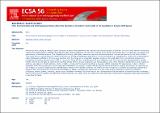Por favor, use este identificador para citar o enlazar a este item:
http://hdl.handle.net/10261/325035COMPARTIR / EXPORTAR:
 SHARE
BASE SHARE
BASE
|
|
| Visualizar otros formatos: MARC | Dublin Core | RDF | ORE | MODS | METS | DIDL | DATACITE | |

| Título: | Environmental and anthropogenic drivers affect the abundance of anchovy and mysids in the Guadalquivir Estuary (SW Spain) |
Autor: | Carvalho-Souza, Gustavo Freire; Llope, Marcos; Baldó, Francisco CSIC ORCID ; Vilas, César CSIC ORCID; Drake, Pilar CSIC ORCID | Palabras clave: | Centro Oceanográfico de Cádiz Estuary Pesquerías GAM anchovy environmental and anthropogenic drivers |
Fecha de publicación: | 15-ago-2016 | Citación: | ECSA 56 Coastal systems in transition: From a 'natural' to an 'anthropogenically-modified' state. (04/09/2016 - 07/09/2016. Bremen (Germany)). today. 0341. En: , . | Resumen: | Natural drivers, acting at various spatio-temporal scales firstly determine the distribution and abundance of species. On top of this natural forcing we usually find anthropogenic effects. Disentangling the relative influence of these two sources of variability has always been a challenge in ecology, and particularly in fisheries science. The Guadalquivir Estuary (SW Spain) serves as nursery ground for several commercial species in the Gulf of Cadiz. This study aims at quantifying the relative influence of biological (predator-prey effects), environmental (e.g. temperature, winds) and anthropogenic (dam discharges) effects on this nursery function with the focus on an important species, anchovy. We used data from a monitoring programme consisting of monthly records since 1997 at two sites: Tarfia (32 km) and Bonanza (8 km) (distance from the river mouth). Nonparametric models (GAM) were fit to the data to estimate the partial effects of the various covariates. We found positive and linear effects of temperature and mysids on anchovy abundance in both stations, while turbidity, winds and freshwater input had a negative effect, reducing fish abundance. A dam, 110 km upstream from the Guadalquivir mouth regulates freshwater discharges, directly influencing the estuarine habitat quality and extent, as captured by our models. In order to separate the anthropogenic effects from natural variability we further ran the models on a number of scenarios combining a range of dam discharges and environmental conditions. Water management stands out as a key node where potentially conflicting interests (irrigators, electric power, shipping, aquaculture, fisheries) converge. By focussing on the consequences that the effects of these activities ultimately have on the anchovy fishery, through this nursery function, our study aims to contribute to the process of making the ecosystem approach operational in the Gulf of Cadiz. | URI: | http://hdl.handle.net/10261/325035 |
| Aparece en las colecciones: | (IEO) Comunicaciones congresos |
Ficheros en este ítem:
| Fichero | Descripción | Tamaño | Formato | |
|---|---|---|---|---|
| Carvalho-Souza_etal (2016) ECSA.pdf | presentation abstract | 138 kB | Adobe PDF |  Visualizar/Abrir |
CORE Recommender
Este item está licenciado bajo una Licencia Creative Commons

